Here I am, going back on the West Highland Way rediscovering the landscapes seen a few days ago but under a sky a little more radiant. The train rides on the uplands of the Highlands in the middle of nature. Nothing, except for a train station out of nowhere. I change train to Crianlarich, where I passed seven days ago. Oban, small port city with pretty houses is the departure port for the ferry to the Outer Hebrides. Archipelago of islands in the west of Scotland, with the Gaelic name of Na h-Eileanan Siar, they gather about twenty islands of different sizes. The largest and most populated (although the total population is around 27,000), are, from south to north: Vatersay, Barra, Eriskay, South Uist, Benbecula, North Uist, Berneray, Harris and Lewis. These are the islands that I will cross during my hike on the Hebridean Way, a 250km hiking trail crossing the archipelago.
I embark in early afternoon on the ferry to Castlebay on Barra Island, where is located the start of the Hebridean Way. About five long hours of boat with a bit of sea-sickness and here I am arrived in a very small village on an island with an heavenly atmosphere. But windy. What a difference! The air is dry but really cold. The gusts of wind make me almost wobble. An hour of walking on the road to reach the other side of the island where I find the path that follows the Hebridean Way. The official start of the trek is on the island of Vatersay, a tiny island south of Barra but I do not have time to go there. I planned to bivouac but the place considered for camping is very windy. It is already 9pm and I hesitate a little. I decide to go to the campsite, 1km further, hoping it will be a little more protected. As I am almost arrived, a very nice old gentleman stops to propose me a ride. I tell him that I am almost at my destination but he insists and I accept. It will probably be my shortest hitchhiking of the trip: only a few meters!
The campsite is even more windy than the bivouac area but I do not have the strength to go back. It is already 9:30pm and I settle for the night. Nobody to cash me. A tiny building serves as a block for showers / toilet / kitchen. But the place contains a treasure: The best showers I have ever seen and wifi whose connection wobbles a bit. It is more than I expected. My tent is crashing a little under the wind and I watch a beautiful sunset before closing my eyes for my first night on the Hebrides.
I wake up under a nice sun that quickly goes away. A massive cloud arrives, pushed by the wind and settles over Barra for the whole day. Everything is gray. Not even a few rays of sun to sneak up. Donald, the manager of the campsite comes to see me as I pack up my tent to collect his due. It’s £10 a night. £10 for a windy location but with the best showers I have seen in Scotland since I arrived. Okay, then.
I leave the campsite and here I am on the Hebridean Way. Two weeks to cross the Outer Hebrides. The path follows the small road through the borough of Borve. Then goes up to the surrounding hills. The trail disappears to make way for a “non-existent trail” left by some walkers before me. Some posts marked “Hebridean Way” positioned every 200m indicate the direction. Nobody. Except some sheep. One female and two small ones. They decamp at my passage. The moor is boggy and my shoes are getting wet. I go up to Beinn Bhirisig, then go down to Loch an Duin before going up to Beinn Eireabhal. The view of the Barra Strait is superb with a hundred small islands and white sand beaches. A small plane lands on the sand spit serving as an airport. Despite the gray weather and the strong wind, the landscape is impressive. I join, in a hurry, the ferry to the tiny terminal of Ardmhor to reach the small island of Eriskay. The sky is finally revealing rays of light followed by blue sky. Under a slightly better sky, I cross Eriskay, enjoying a visit to the local store to buy my evening meal. On a bench watching the incoming sun, I appreciate the calm of the place and the feeling of calm that emerges from it.
The causeway connecting Eriskay to South Uist, is already looming and I follow the road to reach my third island of the day. Three kilometers on the causeway followed by three others to join Kilbridge camping, all on the road. It is long and painful for the feet but the landscape is beautiful. The turquoise sea, the white sand, the dunes, some huts and mountains in the background. Under a late sunny afternoon, I set myself up at the campsite.
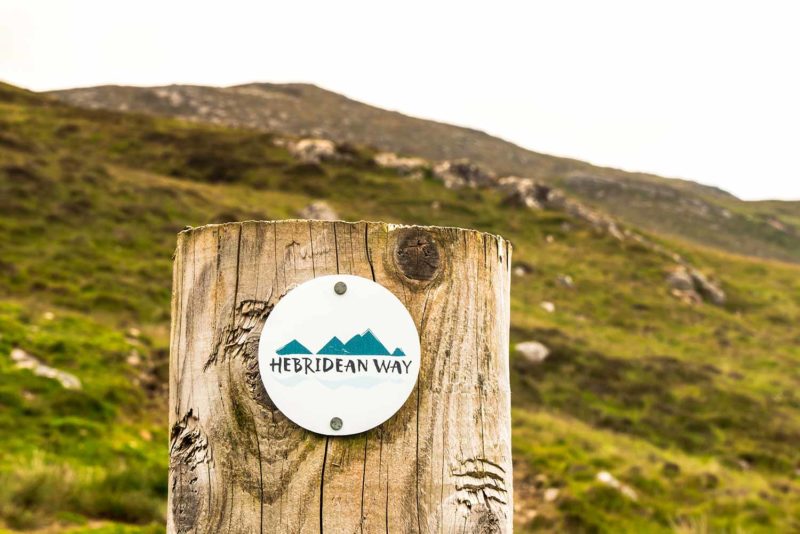
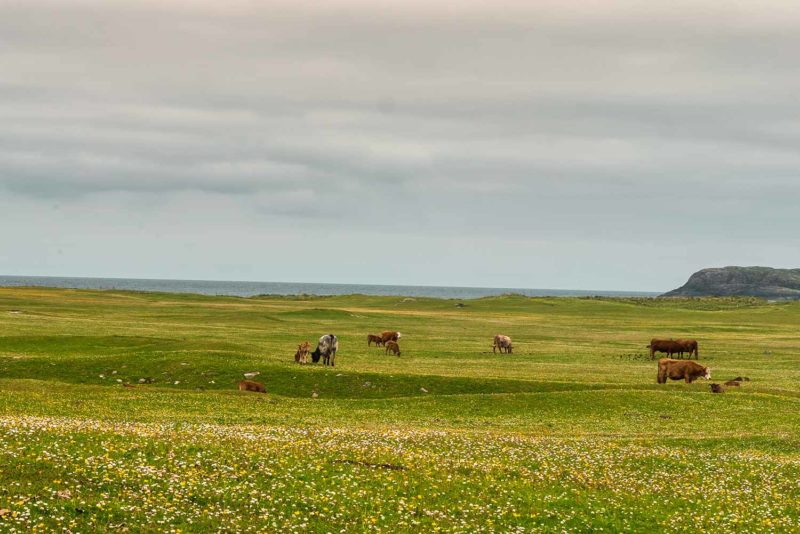
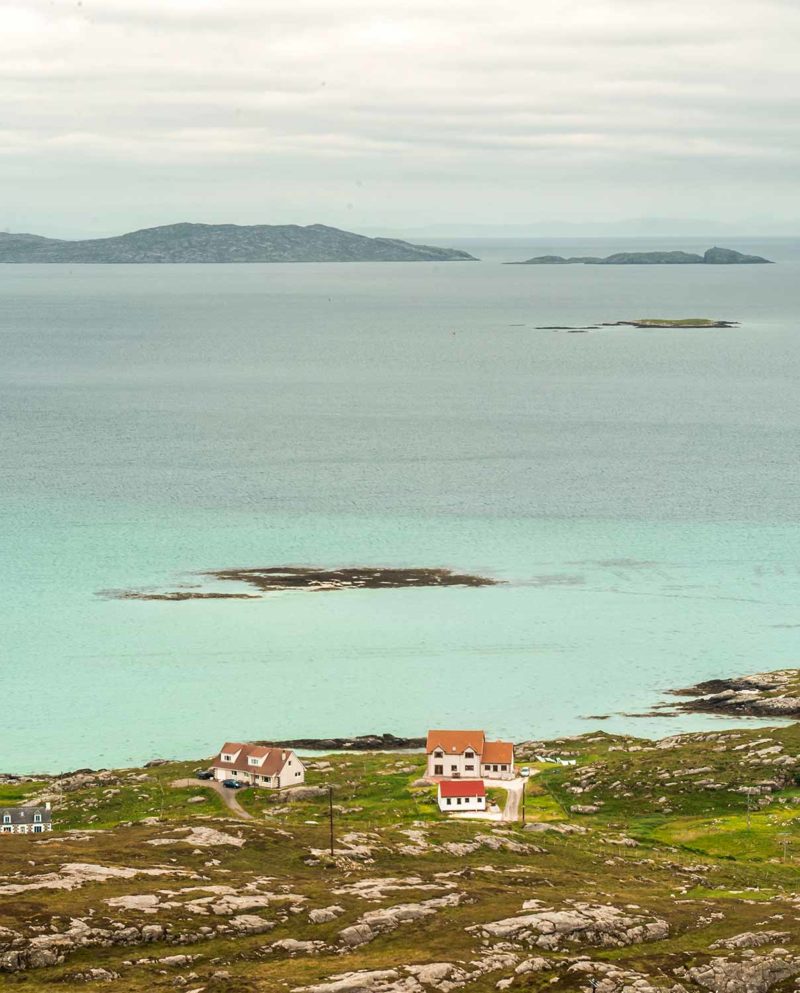
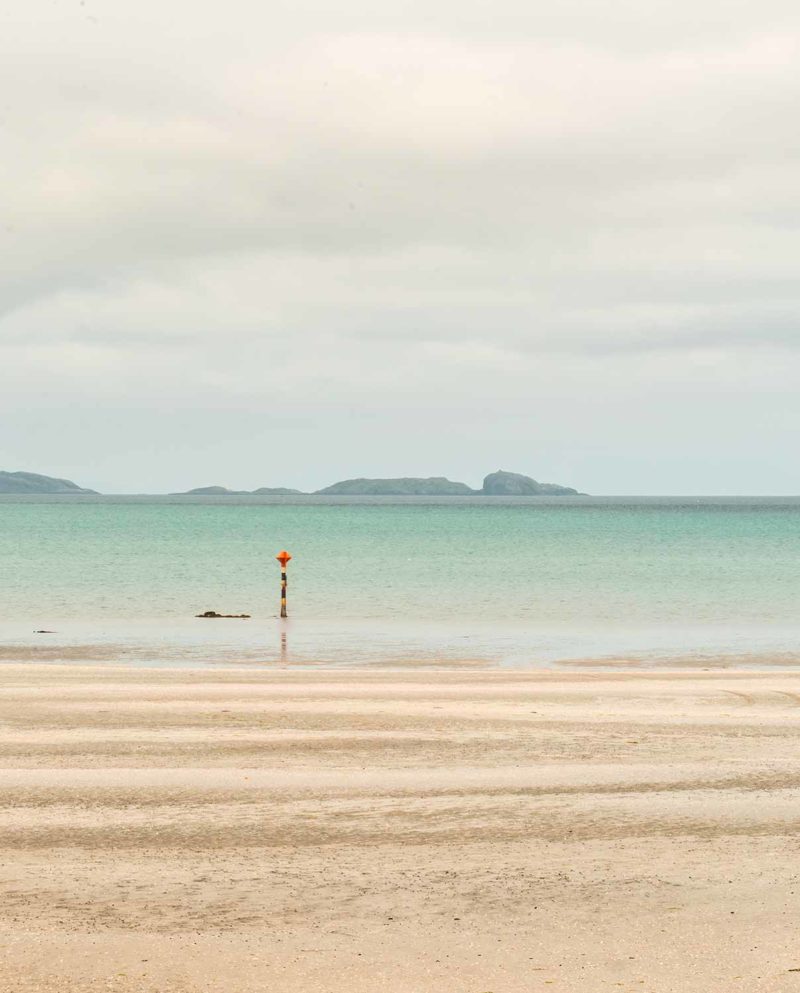
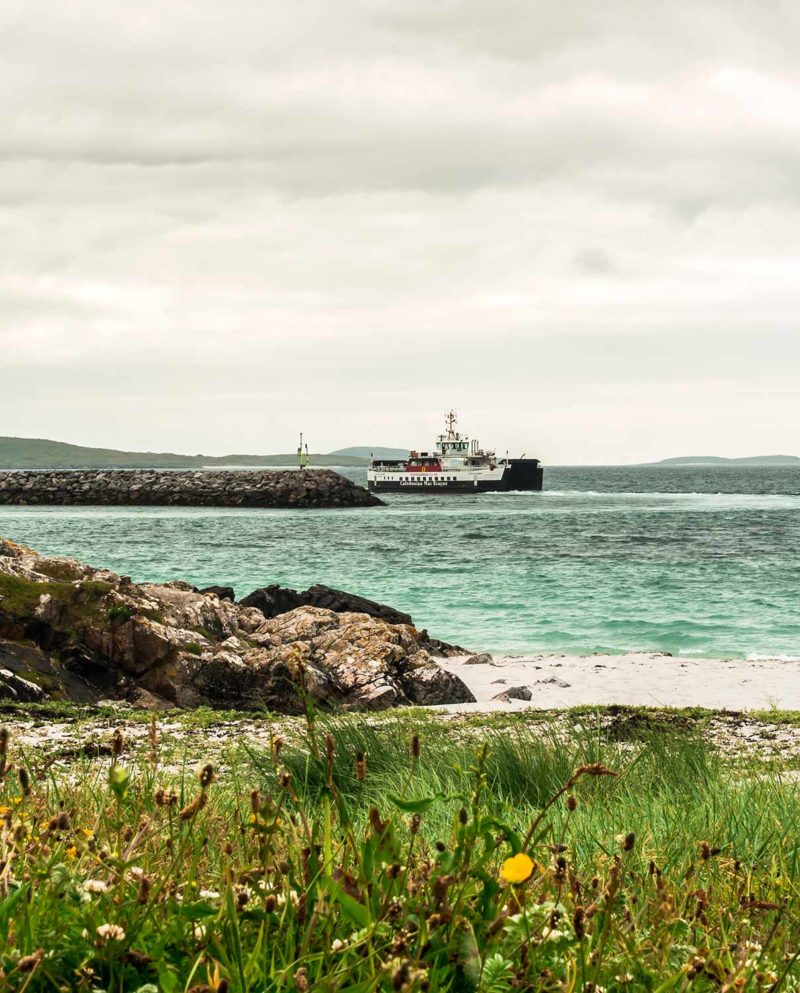
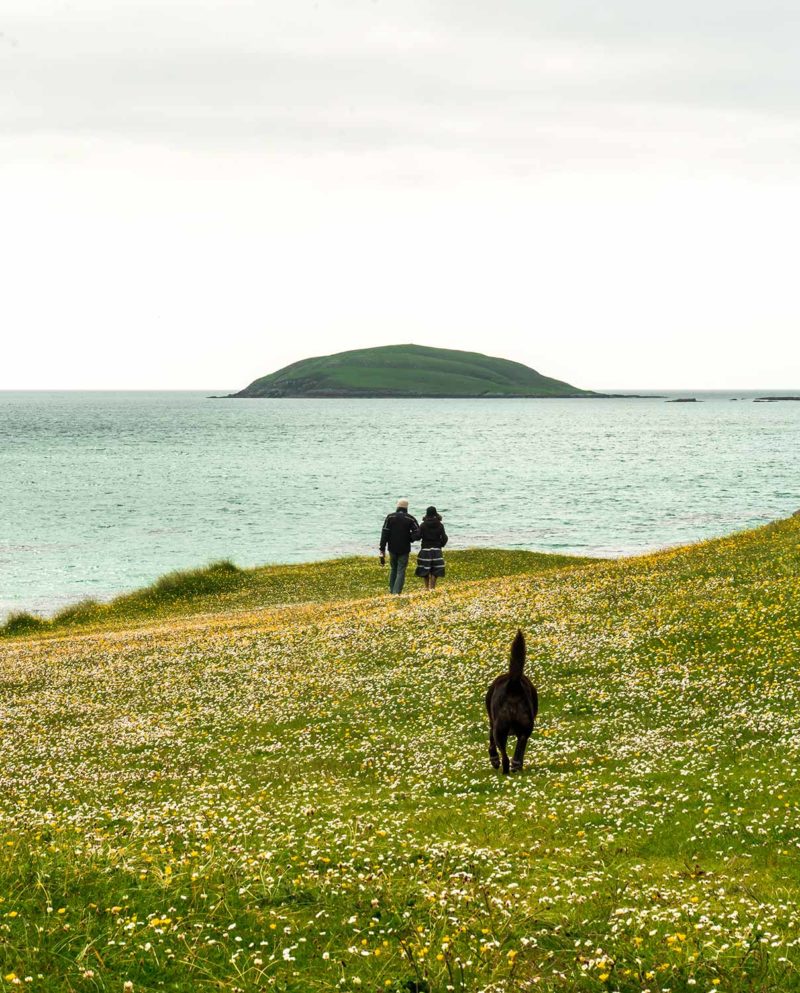
Barra and Eriskay.
Not a cloud in the sky this morning, it is gonna be nice day. It is gonna be a hot day. Breakfast eggs on toast at Kilbridge Café and here I am on the trail. About twenty kilometers along the coast of South Uist to reach the peninsula of Loch Aid a Mhuile. On one side the sea and on the other the meadows carpeted with daisies and golden flowers. The landscape seems to be empty. There is nobody. No noise. In fact it is not true, there is the sound of the sea, the wind whistling in my ears, the twittering of the hundreds of seabirds that are alarmed at my passage. But not a sound of civilization. It is calm, it is empty, it is almost sad. Carcasses of abandoned cars lie in the fields. Witnesses of an island with difficult prosperity? The inhabitants seem to abandon them here, among the flowers, so that they fall slowly into pieces.
The landscape scrolls: the sea, the dunes, the flowers and the mountains in the distance. Always the same. It could be meditative. If only my mind stopped wandering. Just enjoying walking, one step after another, looking at the landscape. The bed of flowers dazzles me at every step. It is green, white and yellow. With a lot of variations. I follow the trace on what remains of the Machair Way. In Gaelic, “Machair” means “low and fertile grasslands”. This environment is only found on the west coast of Scotland and Ireland.
A large golf course appears in the dunes near Askernish. I am hot then cold because of the wind getting stronger. I do not know what I want. I take a short break in the dunes contemplating the sea and swallowing a sandwich bought this morning which falls into pieces. I feel a little strange. Half happy, half sad. Is it due to the monotony of the landscape? The weight of the bag, a little too heavy that hurts my shoulders and leaves me with blisters? By the fact that I do not meet anyone? Yet that is what I wanted. A wilder and less touristic trek than the West Highland Way. My desires have been heard and here I am served. But I feel a little lonely. Despite the beauty of the flowers and birds singing, something seems empty.
I go to the Golf Course Clubhouse to replenish my water for tonight’s bivouac. And I continue through the dunes, thoughts in my head. The wind is blowing in my ears and the sun is slowly turning in the sky. At Loch Aid a Mhuile, no place to camp and quite tired, I have to turn back one kilometer to return behind other dunes, these more welcoming. I put my tent in the middle of daisies and golden flowers and finally lay down, my head filled with question marks and my feet painful. In the middle of the flowers and in the calm of the evening, appreciating the sun which descends and the colors blushing, I revise my route for the continuation, trying to shorten the stages to stay around 16km per day. The end of the day is beautiful, the sun glowing on the horizon and I fall asleep a little comforted.
I wake up, the sun already high in the sky. Same blue sky without clouds. Same bed of daisies. Same absolute calm. Here I go again along the coast for about ten kilometers. At Caisteal Ormacleit, a castle in ruins, I take a short break. I just sat that a strange man, a little ragged, comes to talk to me. In the space of a few minutes, Roddy tells me about his life, his parents and his sister who died recently, the time when he took care of 400 sheep, the crops being harvested now in September rather than July and the castle being destroyed by fire in 1715. But a big wedding is being prepared a little further down the coast, the tents are being installed and he wants to take a look. All this agitation seems to make him happy. I feel that is the mark of a man deeply alone. We separate on a handshake and I continue my way.
At Howmore, I stop for lunch in the gardens of the tiny Gatliff Youth Hostel. Nobody but the place is open allowing me to refill my water. My feet hurt and it is hot. It is hot and the wind is strong. A demonic combination that leave me with no forces. The trail finally leaves the coast and sinks among the many lakes and peat bogs at the foot of the hills. The same habitual thoughts are circling at the edge of my consciousness: why do I push myself to do that? Does the pleasure of hiking mean carrying a heavy bag and walking the trail in its entirety despite the difficulty? Or should the pleasure of the hike be more important? Am I forgetting that I am “on vacation” and that pleasure and simplicity should guide my steps? Do I really like hiking or is it an illusion that I push myself to do?
Back on a small road and motivating me for the last three kilometers to go, a motorhome stops and offers me a lift. I accept with happiness. The lady drops me a few minutes further at the foot of Our Lady of the Isles, a statue of 9m at the effigy of the Madonna and son placed there in the middle of nowhere. A few meters higher on a small hill is a telecommunication relay. I am looking for a place to camp but the ground is sloping and the wind is still blowing hard. I continue a little bit and end up in a small roadside quarry. It is less good than last night but there is not much choice.
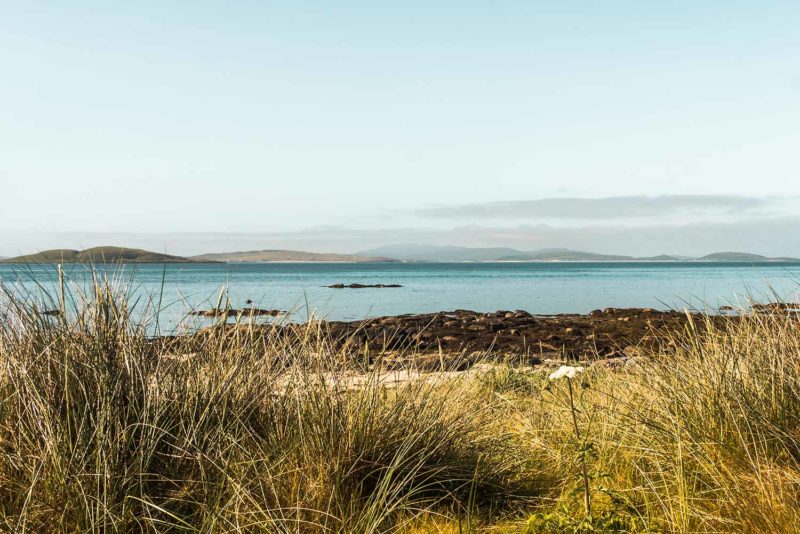
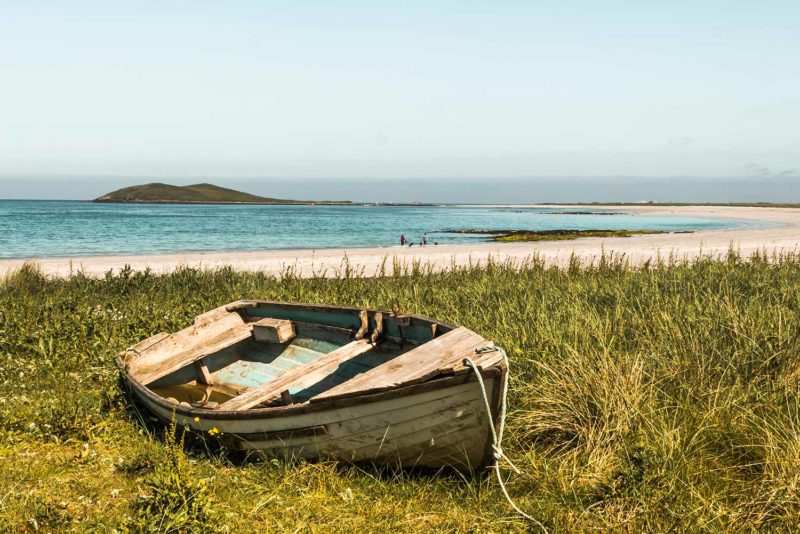
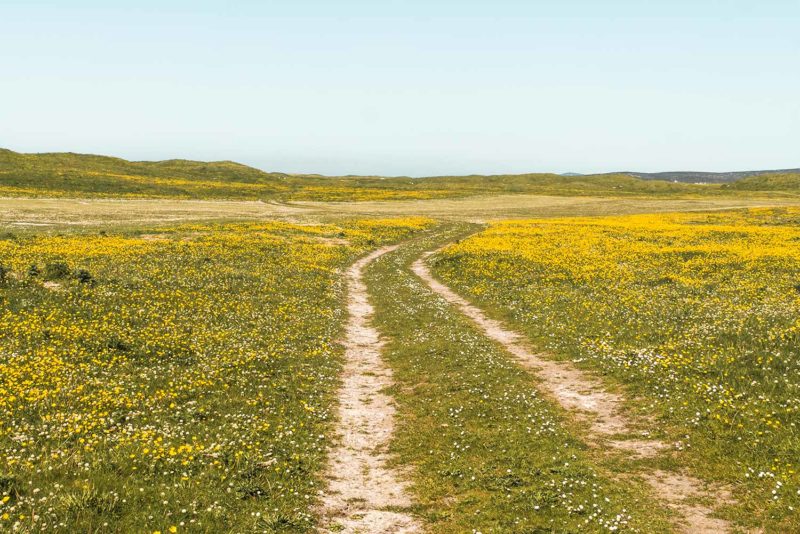
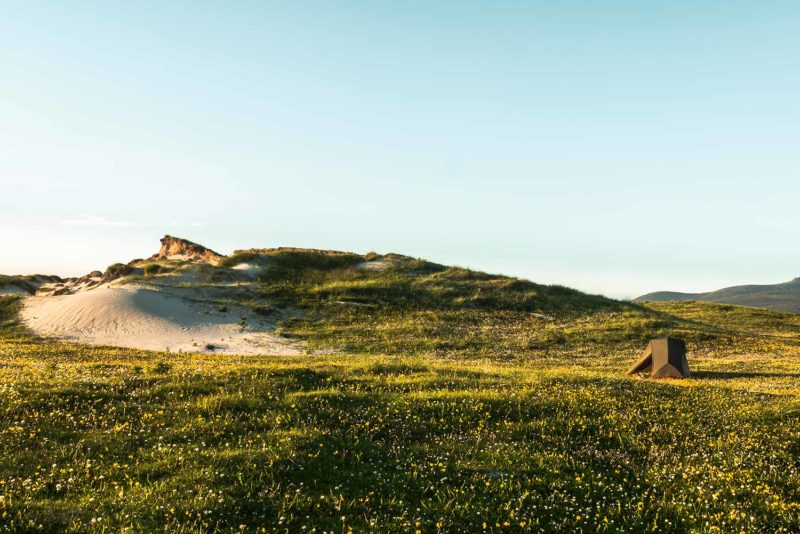
Bivouac in the “Machair” of South Uist.
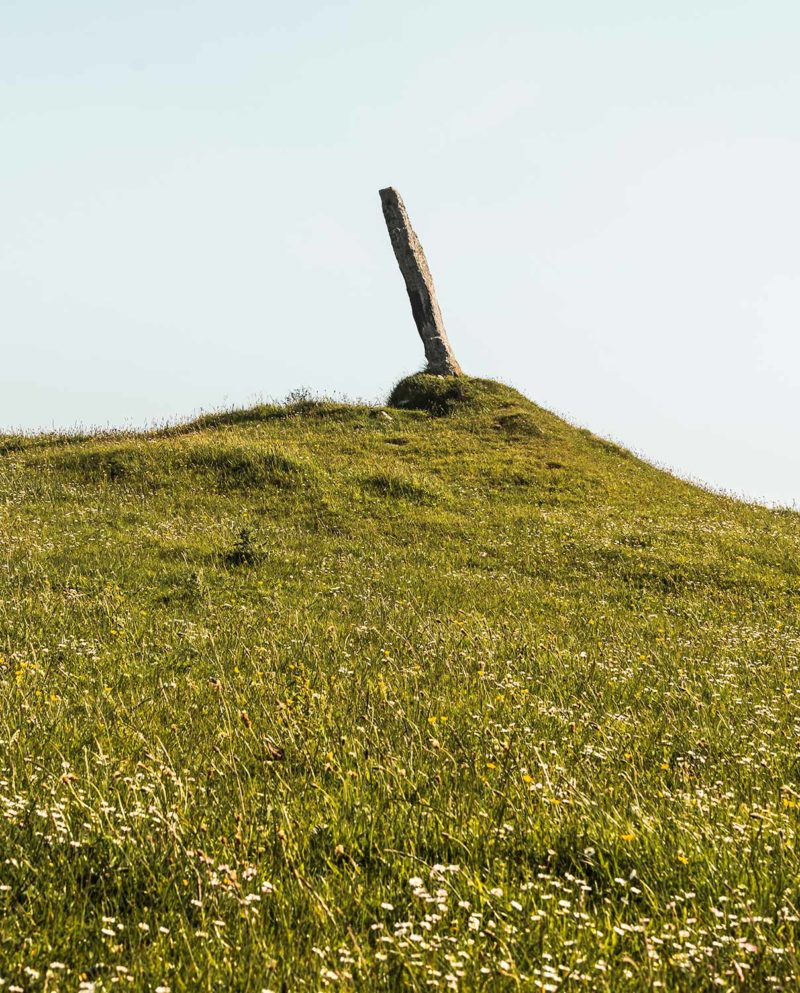

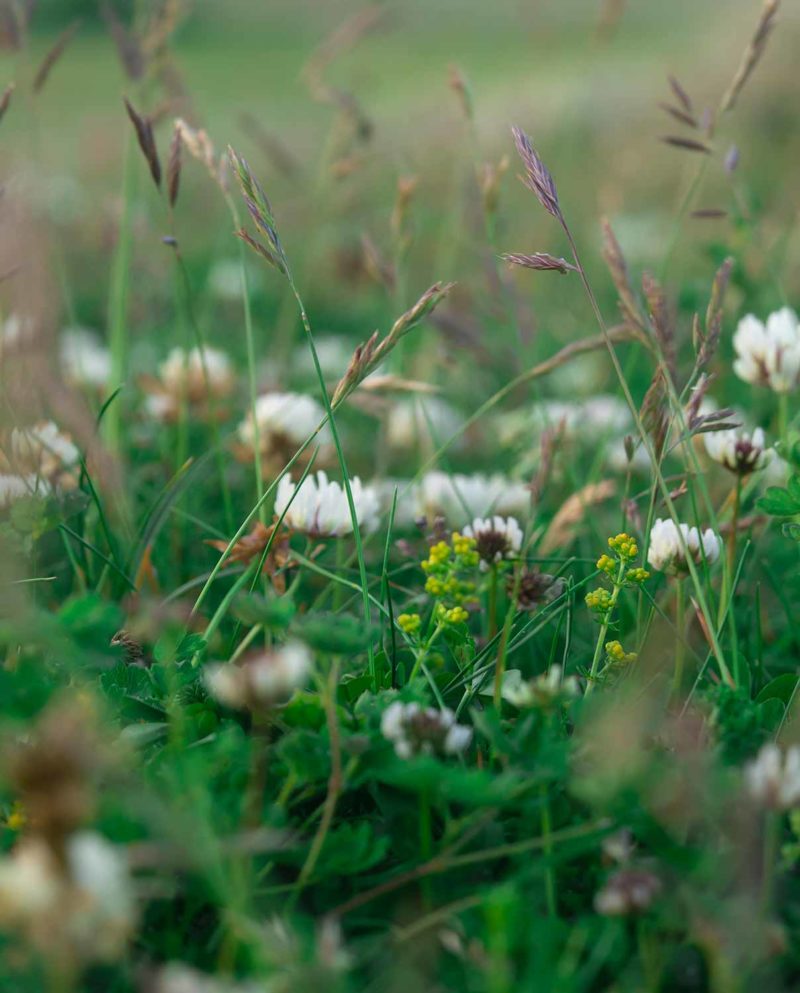
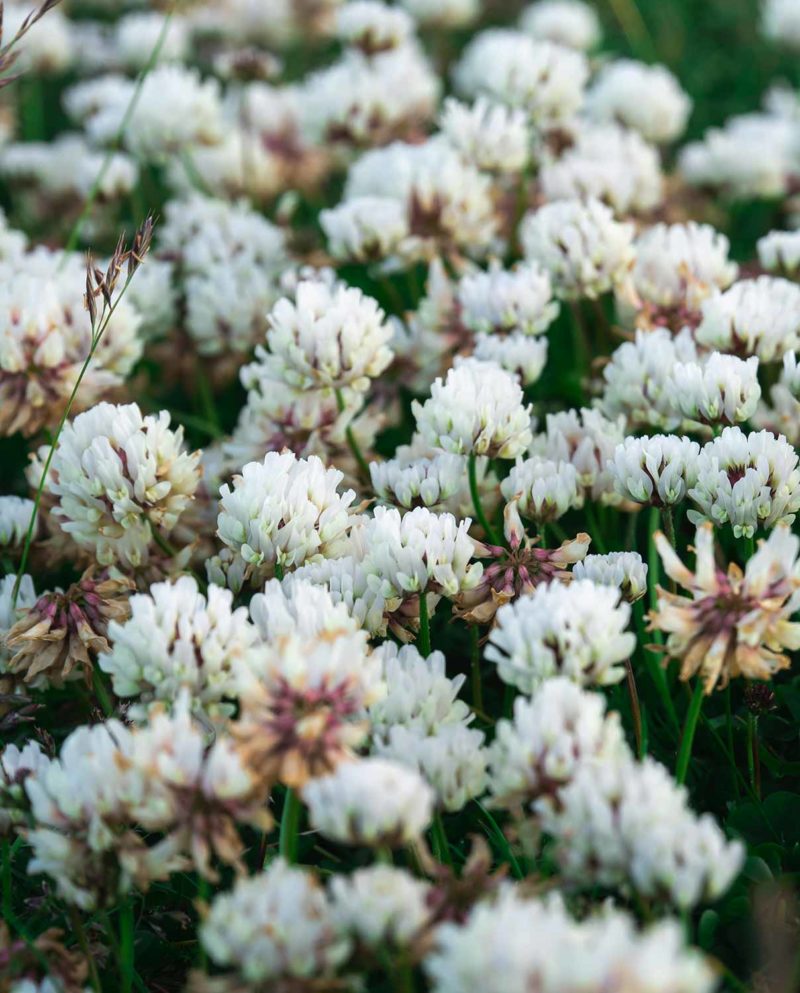
On the left, a menhir.
Wake up under the clouds. It is gray and wet. I pack up my barda fighting with a hundred spiders who have elected home in the corners of my roof tent. This morning I continue through the plain full of lakes and peat bogs. The path disappears and navigates through the peat bogs following the post marks. At every step, the earth seems to want to swallow my shoes. Water is queen here and you have to be careful where to put your feet. The sun appears a little through the clouds and I appreciate the color variations. The progression is not easy, and it is with relief that I reach the three wind turbines of the Lochcarnan Community Wind Farm where I find a path of stones. At a distance the wind turbines always seems to me like fragile and light windmills. Up close, they evoke monsters of technological power. I overtake them listening to the characteristic noise of the pale cutting through the wind.
A flock of horseflies have decided to eat my skin and I do not linger. At least that has the gift of distracting me a little from the monotony of the way across the plain. The bag is a little lighter (far less water now) but I claud a little because of my blisters. Some places in the bog seem to have been returned by man’s hand. Sods of soil are laid in a particular arrangement and I wonder what it can be. It is actually peat cut and dried in the sun so that it can then be used as fuel for fire. The inhabitants of the Hebrides have been using peat for a long time to fuel their fires. Although less powerful than wood, peat emits a pleasant odor while consuming itself.
A pretty traditional thatched cottage appears on the edge of a loch but it is low tide and the water is gone. Only the mud and masses of brown algae remain. And three sheep perched on rocks nibbling the last remnants of green grasses. I cross the causeway linking South Uist to Benbecula and here I am on a new island. Lunch break and refreshments at the local supermarket. And I take the bus for the last three kilometers separating me from the campsite. After three days and two nights “in the heart of nature”, I happily welcome a hot shower and a quiet end of afternoon.
Three o’clock in the morning. A wind to make cows fly wakes me up. The announced storm has finally arrived. Wind and rain have decided to crash hard on the shore. My tent is tossed in all directions and even if I do not doubt (not too much) of its resistance, I can not close my eyes. I retreat into the showers taking all my stuff with me and quickly folding my tent. Not really a comfortable place to sleep but at least I am safe. I doze for the rest of the night while waiting for the sunrise.
When I emerge from my half-torpor, it is stormy and the wind has strengthened. The weather forecast does not look good for the day or the next night and I decide to review my plans. I have to find an inn or a hotel so I can sleep in a sheltered place and especially sleep. Sleep well because it has been three nights that I do not sleep very well. About six kilometers further is the small hamlet of Baile Nan Cailleach, where there is a youth hostel. This will be my destination for the day.
The path runs along the shore and I am bumped on all sides by the wind and the rain. Around 10:30am I arrive at the hostel where I put down my big bag and decide to continue the way to climb to Ruabhal. Benbecula Island is as flat as a coin. If not for the small hill of Ruabhal, 124 meters high, placed almost in the center of the island. The Hebridean Way climbs its summit to enjoy the views of the surroundings and then descends on the other side before finding the road and reaching the island of North Uist. Given the weather, I am just going to climb up and come back to the hostel.
The rain has calmed down a bit and I leave on the road. Seven kilometers in a straight line to reach Ruabhal. The hill seems to take an eternity to get closer. At the top, gusts of 70km/h make me wobble. I distinguish through the cloud cover and the squalls of rain, the infinity of small lakes that make up the island. An impatient cloud suddenly pours me over and I decide to go down. But the rain disappears as quickly as it arrived and the landscape is revealed then a little more. I can see in the distance the hills of North Uist in the clouds.
Seven kilometers long and monotonous in the other direction and here I am back to the inn, quite tired. Four cyclists have arrived in the meantime and we spend the evening chatting quietly. Today, walking in the rain, wavering under the gusts of wind, the questions that have occupied my mind for several weeks have come back in force. Why do I walk? And why walk in difficult conditions? The landscape is dreary, the atmosphere is sad, the weight of the bag hurts my shoulders, I am tired, and I do not enjoy walking. So why continue? Is it precisely when the conditions are difficult, when the spirit pushes to give up that it is necessary to continue? Is one of the big lessons to be learned is that I have to let go of my expectations and calmly accept what I receive, even if it does not suit me?
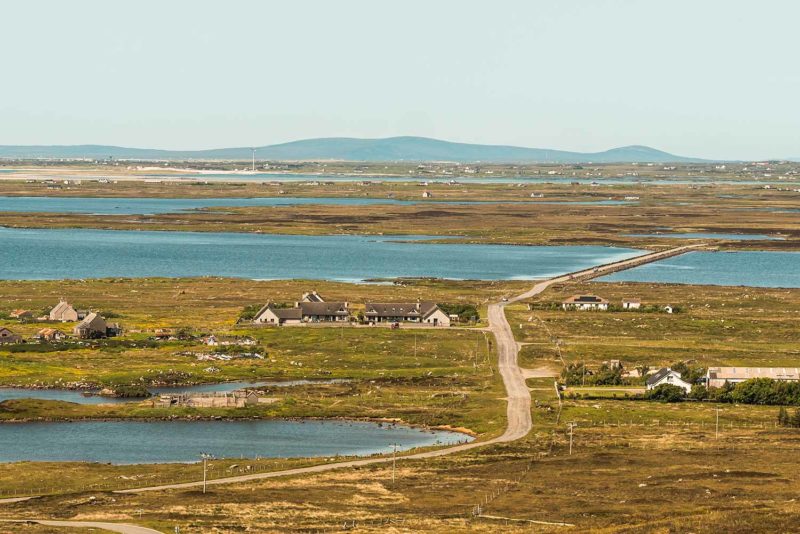
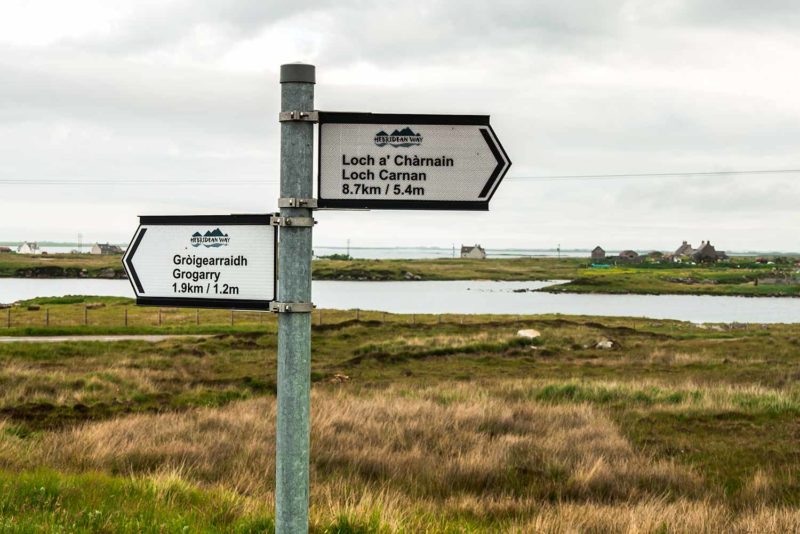
Towards Benbecula.
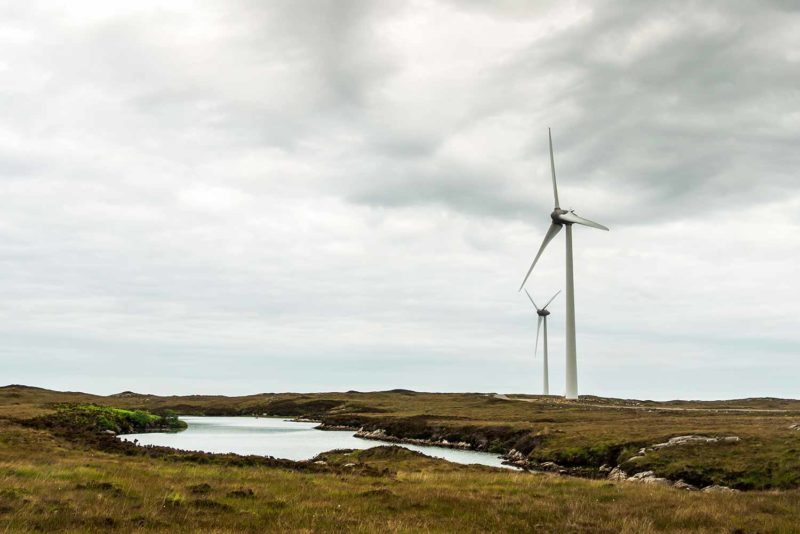
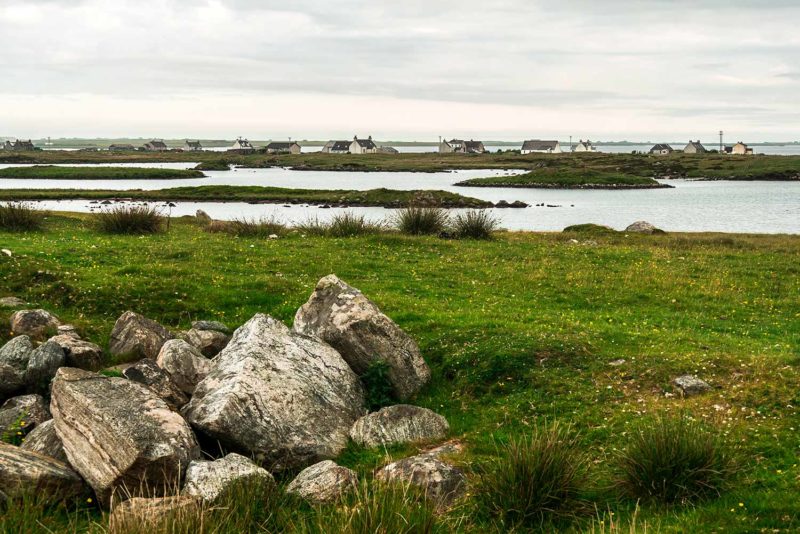
Lochcarnan Community Wind Farm.
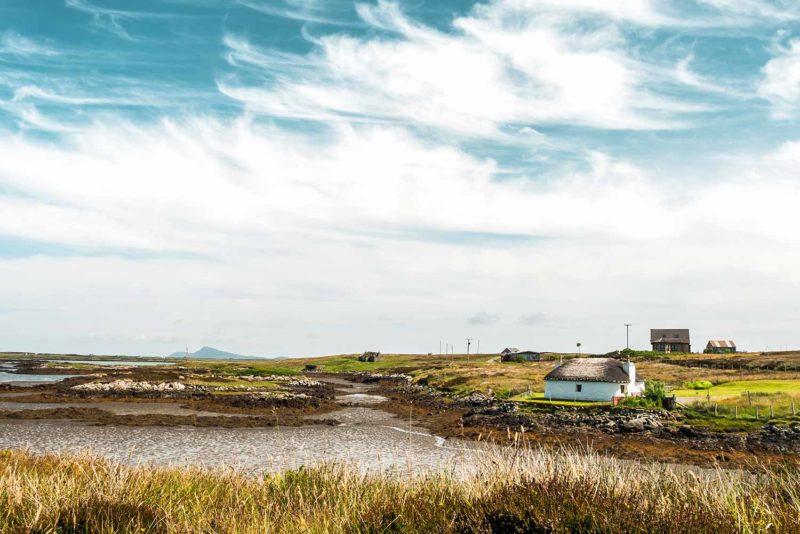
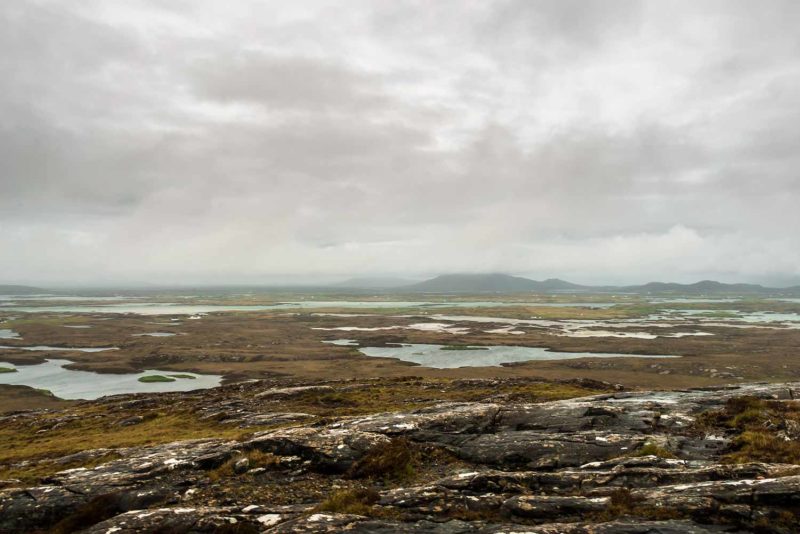
On the left, a traditional cottage and on the right, the view from the top of Ruabhal.
